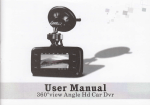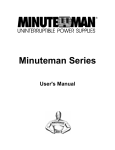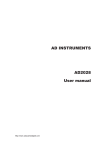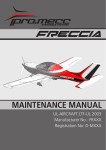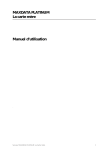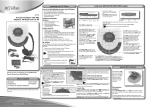Download Harbor Freight Tools 43150 User's Manual
Transcript
Metal Detector Model 43150 Assembly and Operating Instructions 3491 Mission Oaks Blvd., Camarillo, CA 93011 Copyright 2000 by Harbor Freight Tools®. All rights reserved. No portion of this manual or any artwork contained herein may be reproduced in any shape or form without the express written consent of Harbor Freight Tools. For technical questions and replacement parts, please call 1-800-444-3353. Revised Cover 09/04 Specifications Stem Length: Coil: Power Supply: Battery Tester: Audio: Weight: 15-1/2” X 28-1/2” 6-1/2” Diameter Qty 6, AA Batteries Yes, built-in 3 distinctive sounds for different metals 1.8 Lbs. Save This Manual You will need the manual for the safety warnings and precautions, assembly instructions, operating and maintenance procedures, parts list and diagram. Keep your invoice with this manual. Write the invoice number on the inside of the front cover. Keep the manual and invoice in a safe and dry place for future reference. Safety Warnings and Precautions WARNING: When using tool, basic safety precautions should always be followed to reduce the risk of personal injury and damage to equipment. Read all instructions before using this product! 1. Handle the Metal Detector carefully at all times. Dropping the Metal Detector can cause damage to circuit boards and the case, which can cause the product to work improperly. 2. Only use and store the Metal Detector in normal temperature environments. Extremes in temperature can shorten the effectiveness of electronic devices and melt or damage plastic parts. 3. Avoid electrical shock. Any metal detector may discover underground power lines, explosives or other items which when struck could cause personal injury. Do not use this product in areas where there might be underground electric lines or pipes buried at shallow depths. Never search in military zones where bombs or other explosives may be buried. Avoid striking any line known or suspected to be carrying electric power. Do not search any pipeline, particularly if it could contain a flammable gas or liquid. In areas of uncertain conditions, use reasonable caution before using the Metal Detector. If there is any question about a condition being safe of unsafe, do not operate the Metal Detector. 4. Keep the Metal Detector clean. Wipe the housing after each use. The search coil is washable and can be fully submerged. Never submerge the control housing. Protect the control housing from rain, blowing surf and heavy mist. Disassemble the stem and wipe it clean after use in sandy areas. 5. Dress properly. Do not wear loose clothing or jewelry as they can be caught in moving parts. Protective, electrically nonconductive clothes and nonskid footwear are recommended when working. Wear restrictive hair covering to contain long hair. 6. Use the right tool for the job. Do not attempt to force a small tool or attachment to do the work of a larger industrial tool. There are certain applications for which this tool was designed. Do not modify this tool and do not use this tool for a purpose for which it was not intended. 7. Stay alert. Watch what you are doing, use common sense. Do not operate any tool when you are tired. #43150 Page 2 Safety Warnings and Precautions (continued) 8. Check for damaged parts. Before using any tool, any part that appears damaged should be carefully checked to determine that it will operate properly and perform its intended function. Check for alignment and binding of moving parts; any broken parts or mounting fixtures; and any other condition that may affect proper operation. Any part that is damaged should be properly repaired or replaced by a qualified technician. Do not use the tool if any switch does not turn On and Off properly. 9. Replacement parts and accessories. When servicing, use only identical replacement parts. Use of any other parts will void the warranty. Only use accessories intended for use with this tool. Approved accessories are available from Harbor Freight Tools. 10. Do not operate tool if under the influence of alcohol or drugs. Read warning labels on prescriptions to determine if your judgment or reflexes are impaired while taking drugs. If there is any doubt, do not operate the tool. 11. Maintenance. For your safety, maintenance should be performed regularly by a qualified technician. 12. People with pacemakers should consult their physician(s) before using this product. Electromagnetic fields in close proximity to a heart pacemaker could cause interference to or failure of the pacemaker. Warning: The warnings, cautions, and instructions discussed in this instruction manual cannot cover all possible conditions and situations that may occur. It must be understood by the operator that common sense and caution are factors which cannot be built into this product, but must be supplied by the operator. Unpacking When unpacking, check to make sure all parts shown on the Parts Diagram and Parts List are present. If any parts are missing or broken, please call Harbor Freight Tools at the number on the cover of this manual. Preparing to Operate Adjusting the Stem 1. Turn locknut clockwise until it becomes loose (see Figure 1). Adjust the stem so when you are standing upright with the detector in your hand, the search coil is level with and about 1/2 to 2 inches above the ground when your arm is relaxed at your side (see Figure 2). Figure 1 Figure 2 Turn the stem’s lock nut counterclockwise to lock it in place. Adjusting the Search Coil Loosen the Knobs at the end of the Search Coil (the Search Coil should be parallel with the ground). Tighten the Knobs enough to keep the Search Coil from wobbling or rotating (see Figure 3). #43150 Figure 3 Page 3 Rev 05/06 Battery Installation The Metal Detector requires the use of six AA bateries. Do not mix old and new batteries and do not mix different types of batteries. 1. If the Metal Detector is on, turn the volume on the control housing to OFF (see Figure 4). 2. Press on the battery compartment cover and slide the cover Figure 4 off in the direction of the arrow (see Figure 5). 3. Insert the batteries into the compartment as indicated by the polarity symbols (+ and -) which are marked inside the compartment (see Figure 6) Replace the cover. Remember to remove batteries if you do not plan on using the Metal Detector for a week or more. Figure 5 Figure 6 Testing Batteries: Always test the battery power when the Metal Detector does not turn on, has weak volume, will not tune properly, or has erratic operation. Rotate VOLUME away from OFF and set OPERATE / BATT to BATT TEST (see Figure 7). If the pointer on the viewmeter is between 3 and 6 (green area), the batteries have enough power to operate the detector. If the pointer is not in the green area, replace the batteries. Figure 7 Using Earphones: Stereo earphones (not included) can be connected to the Metal Detector. Using earphones saves battery power and makes it easier to identify changes in the sound patterns. Earphones are connected to the ear jack on the side of the Control Housing Figure 8 (see Figure 8). When using earphones, protect your hearing by: a. Set the volume to the lowest setting before you begin listening. Adjust the volume to a comfortable level. b. Never listen at extremely high volume levels; permanent hearing loss can result. c. Once the volume is set, do not increase it. Over time, your ears adapt to the volume level, so a volume level that does not cause discomfort might still damage your hearing. #43150 Page 4 Operation: This metal detector distinguishes between ferrous and non-ferrous metals. Ferrous metals contain iron. Non-ferrous metals do not (examples: gold, silver, copper, platimum, aluminum, lead, and zinc). When the Metal Detector senses a metallic object, the meter reading changes and the detector might sound a tone. The reaction depends on what metal is detected. Turning on and Tuning the Metal Detector: While holding the detector in a comfortable position, rotate the VOLUME away from OFF to the desired sound level. Set OPERATE/BATT TEST to OPERATE to detect (see Figure 9). TUNE fine tunes the balance between the detector’s receiver and transmitter. This provides consistent pointer and tone indications. To set TUNE: Rotate VOLUME to the 11 o’clock position. Set DISCRIMINATION to its midpoint (see Figure 10). Hold the search coil about 1 foot from the ground. Hold down the red button on the handle, and slowly rotate TUNE left to right until the pointer on the viewmeter rests at or near 0; then release the red button. Figure 9 Figure 10 As the search continues, you can fine-tune the detector using DISCRIMINATION. Note: To return the pointer to 0 at any time, simply press down on the red button. Figure 11 To Test and Use the Metal Detector: Before using the detector for the first time, you should test the unit to see how it reacts to differnet metals. You can conduct this test outdoors or indoors. For indoor test: 1. After removing watches, rings or any other metal jewelry, place the detector on a wooden or plastic table (search coil’s angle so that the flat part faces upward) - see Figure 12. Note: never test on a floor inside a building, as it may have a type of metal present. 2. Rotate VOLUME to the 11 0’clock position. 3. Set DISCRIMINATION to its midpoint. 4. Take the sample of material to be tested (example: coin or gold ring) and place it about 2 inches above the search coil. Note: the Metal Detector will not detect without motion. You must move the Figure 12 object since you are not sweeping the Metal Detector. #43150 Page 5 For Indoor Test (continued) 5. If the detector detects the material, it sounds a tone and the pointer moves to the left (ferrous) or to the right (non-ferrous) while the detector determines the type of metal it is detecting (see Figure 13). 6. If the detector does not detect the material, the battery power may be low. Also verify that the search coil is properly connected. The detector may also need to be fine tuned (see directions below and on the next page. Figure 13 Outdoor Testing and Use: 1. Locate an area outdoors where there is no metal present. Place a sample of the material to be tested (coin or gold ring) on the ground. 2. Rotate VOLUME about two-thirds clockwise. 3. Press and release the red button on the handle. Slowly rotate TUNE until the pointer is at or near 0. A tone should be barely heard. 4. With the search coil being held approximately 1 to 2 inches above the ground, slowly move the search coil over the area where you placed the sample. Sweep in a side to side motion as follows: Sweep slowly to avoid missing targets. Never raise the sweep coil while sweeping; sweep back and forth as if it was a pendulum (see Figure 14). Figure 14 If the detector successfully detects the material, it will sound a tone and the pointer will move to the type of metal it found. If nothing was detected, try again (make sure the search coil is being moved properly). The detector will respond strongly when it detects most valuable metal oljects. If the signal does not repeat after being swept over the target a few times, the target is probably junk metal. False signals can occur from electrical interference, large, irregular pieces of junk metal, or finding trash on the ground. False signals usually occur broken or are non-repeatable. After finding a metal item, wait a few seconds after the tone stops before continuing; this allows the detector time to reset. You can also press the red button on the handle to return the pointer to the center of the viewmeter. Fine Tuning the Metal Detector: Once you practice with the unit, you can fine tune it to make it more selective in what is found. The ability to distinguish between different types of metal is termed discrimination. #43150 Page 6 The DISCRIMINATION setting determines whether the detector will distinguish between different types of ferrous and non-ferrous metals. You can set DISCRIMINATION to the minimum level (fully counterclockwise) or to the maximum level (fully clockwise) or anywhere in between. As you set it to higher levels, the detector first does not detect small pieces of silver paper, then thick foil, and finally metal objects like pull tabs from soda cans (see Figure 15). Note: As you move to a new area, you must adjust DISCRIMINATION. Figure 15 As you sweep the search coil back and forth over the ground surface you will recognize the difference between signals that occur at random and signals that are stable and repeatable. The key is to dig only for those targets that produce a strong, repeatable signal. This will prevent you from wasting time focusing on trash induced signals. No metal detector is totally accurate. Many conditions influence the success of metal detection. Among the factors that influence results are the angle at which the object rests in the ground, the depth of object, the amount of iron the object contains and the size of the object. To accurately pinpoint a target: 1. Once the detector detects a target that is buried, continue to sweep the search coil over the target in a narrowing side-to-side motion. 2. Stop the search coil directly over the spot on the ground. Then move the search coil straight forward away from you and straight back towards you. Make a mental note of the exact spot on the surface where the detector beeps. Repeat these steps in an X pattern. The target should be directly below the X at the area where the loudest response is heard. Troubleshooting: Problem False signals are being displayed Once a target is found, the display does not show the correct metal type #43150 Suggestion for Cure Sweeping too fast or at the wrong angle. Heavily oxidized metals are detected. Pinpoint the target from several different angles. If the detector does not display and sound the same signal each time, the target is probabley heavily oxidized metal. May be more than one target in the area. If target is heavily oxidized, an incorrect reading may occur. This does not signify a problem with the detector. It may be a type of metal which is not recognizable to the detector. Page 7 #43150 Page 8 #43150 Page 9 #43150 Page 10 #43150 Page 11 PLEASE READ THE FOLLOWING CAREFULLY THE MANUFACTURER AND/OR DISTRIBUTOR HAS PROVIDED THE PARTS DIAGRAM IN THIS MANUAL AS A REFERENCE TOOL ONLY. NEITHER THE MANUFACTURER NOR DISTRIBUTOR MAKES ANY REPRESENTATION OR WARRANTY OF ANY KIND TO THE BUYER THAT HE OR SHE IS QUALIFIED TO MAKE ANY REPAIRS TO THE PRODUCT OR THAT HE OR SHE IS QUALIFIED TO REPLACE ANY PARTS OF THE PRODUCT. IN FACT, THE MANUFACTURER AND/OR DISTRIBUTOR EXPRESSLY STATES THAT ALL REPAIRS AND PARTS REPLACEMENTS SHOULD BE UNDERTAKEN BY CERTIFIED AND LICENSED TECHNICIANS AND NOT BY THE BUYER. THE BUYER ASSUMES ALL RISK AND LIABILITY ARISING OUT OF HIS OR HER REPAIRS TO THE ORIGINAL PRODUCT OR REPLACEMENT PARTS THERETO, OR ARISING OUT OF HIS OR HER INSTALLATION OF REPLACEMENT PARTS THERETO. Note: Some parts are listed and shown for illustraion purposes only and are not available individually as replacement parts. #43150 Page 12 Parts Diagram #43150 Page 13















